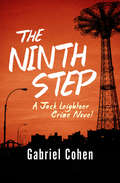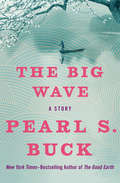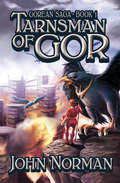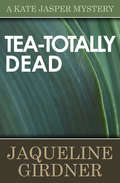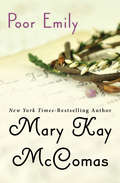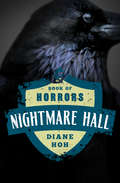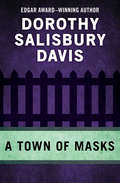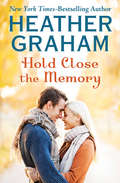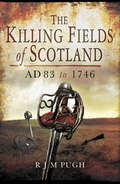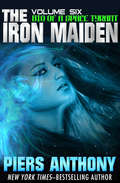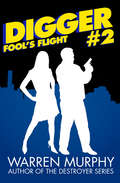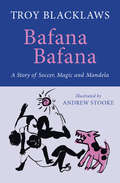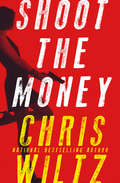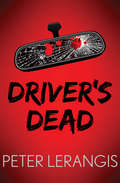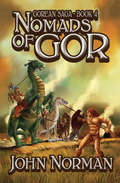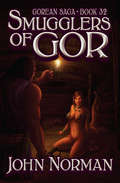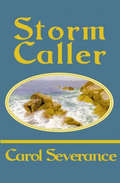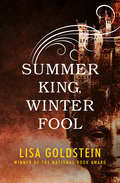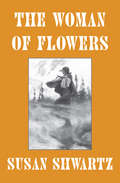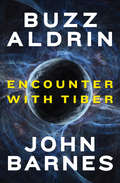- Table View
- List View
The Lilly Library from A to Z: Intriguing Objects in a World-Class Collection (Well House Books)
by Darlene J. SadlierA beautifully illustrated look inside of Indiana University Bloomington’s renowned library of rare books, manuscripts, and related oddities. What do locks of Edgar Allan Poe’s hair, Sylvia Plath’s attractive handmade paper dolls, John Ford’s Oscars, and Ian Fleming’s James Bond 007 cigars have in common? They are just a few of the fascinating objects found in the world-famous Lilly Library, located on the campus of Indiana University Bloomington. In this beautifully illustrated A-to-Z volume, Darlene J. Sadlier journeys through the library’s wide-ranging collections to highlight dozens of intriguing items and the archives of which they are a part. Read about life and death masks of John Keats, Abraham Lincoln, and Theodore Dreiser; Walt Whitman’s last pencil; and vintage board games, mechanical puzzles, and even comic books. Among the more peculiar items are a pair of elk teeth and an eerily realistic wall-mount bust of Boris Karloff. Sadlier writes engagingly about the Lilly Library’s major historical collections, which include Civil War diaries and a panopticon of the war called the Myriopticon; War of 1812 payment receipts to spies; and the World War II letters and V-mail of journalist Ernie Pyle. This copiously illustrated, entertaining, and educational book will inspire you to take your own journey and discover for yourself the wonders of the Lilly Library.
The Ninth Step: Red Hook, The Graving Dock, Neptune Avenue, And The Ninth Step (The Jack Leightner Crime Novels #4)
by Gabriel CohenIn this fourth novel in Edgar Award finalist Gabriel Cohen&’s acclaimed crime series, Brooklyn homicide detective Jack Leightner reopens the case of his brother&’s death four decades later. Cutting class, young Jack Leightner and his brother, Petey, are playing near the Brooklyn waterfront when they find a hidden case of Scotch. They are carrying it home when two teenagers from outside the neighborhood stop them and demand they hand over the booze. Jack refuses, and one of the muggers draws a knife, changing Jack&’s life forever. Forty years later, now a veteran of the elite Brooklyn South Homicide Task Force, Leightner still has not come to grips with that fateful day in Red Hook. He is making breakfast one morning when a man appears on his doorstep and introduces himself as Petey&’s killer. Leightner could arrest him, but the man makes him a deal: Let me go and I&’ll tell you the real reason I stabbed your brother. As Leightner digs into the hidden causes of his family tragedy, he finds his brother&’s murder was about much more than a case of Scotch.The Ninth Step is the 4th book in the Jack Leightner Crime Novels, but you may enjoy reading the series in any order.
The Big Wave
by Pearl S. BuckThe classic tale of a Japanese boy orphaned by a tsunami from the author of The Good Earth, the first American woman to win the Nobel Prize in Literature. On a mountainside in Japan, two boys enjoy a humble life governed by age-old customs. Jiya belongs to a family of fishermen; his best friend, Kino, farms rice. But when a neighboring volcano erupts and a tidal wave swallows their village—including Jiya&’s family—life as they know it is changed forever. The orphaned Jiya must learn to come to terms with his grief. Now facing a profoundly different life than the one he&’d always taken for granted, he must decide on a new way forward. Written with graceful simplicity, The Big Wave won the Children&’s Book Award of the Child Study Association of America when it was first released. This ebook features an illustrated biography of Pearl S. Buck including rare images from the author&’s estate.
Tarnsman of Gor: Gor Book 1 (Gorean Saga #1)
by John NormanThe first novel in the long-running sword-and-planet series set on a Counter-Earth, where warriors rise above the chaos of bondage and brutality. Tarl Cabot has always believed himself to be a citizen of Earth. He has no inkling that his destiny is far greater than the small planet he has inhabited for the first twenty-odd years of his life. One frosty winter night in the New England woods, he finds himself transported to the planet of Gor, also known as Counter Earth, where everything is dramatically different from anything he has ever experienced. It emerges that Tarl is to be trained as a Tarnsman, one of the most honored positions in the rigid, caste-bound Gorean society. He is disciplined by the best teachers and warriors that Gor has to offer . . . but to what end? Rediscover this brilliantly imagined world where men are masters and women live to serve their every desire. Tarnsman of Gor is the 1st book in the Gorean Saga, but you may enjoy reading the series in any order.
Tea-Totally Dead (The Kate Jasper Mysteries #5)
by Jaqueline GirdnerKate Jasper, Marin County, California&’s own organically grown amateur sleuth, returns in this fifth mystery in the series. Kate&’s sweetie has finally moved his malevolent mother, Vesta, out of their house and into her own condo in Tea-Totally Dead. But Vesta uses her new home to host a family reunion for each and every member of her extended family. Attendance is compulsory, even for Kate. Vesta baits, insults, and slanders all the guests but her UFO‑abductee roommate, Harmony, until after‑dinner tea time. Vesta cannot interest anyone else in her private blend of herbal tea, which gives off the pungent bouquet of brewed sweat socks. Luckily for them, since the tea also has an extra infusion of poison that evening. By the following morning, Vesta is as dead as any affection her family might have held for her. And it is up to Kate to find the real fiend of the family.
Poor Emily
by Mary Kay McComasA professor kindles passion, but hides his true motives, in this enticing drama about the chances we take for loveNoble McEntire is the perfect excuse for Emily Becket to change her straitlaced ways. Tall, dark, and devastatingly handsome, he is new to her small Southern town, which makes him even more alluring. And as it happens, Noble is interested in the Civil War–era letters in her attic that might hold the key to clearing the name of Noble&’s maligned ancestor—and she&’s very interested in Noble. But while Emily finds him irresistible and is ready to give herself up to him in unconditional surrender, the professor has deceitful plans of his own. With its unexpected plot twists, Poor Emily is an addictive blend of mystery and romance. This ebook features an extended biography of Mary Kay McComas.
Book of Horrors (Nightmare Hall #16)
by Diane HohReed would die to work for Victoria McCoy—and she may get the chance to do just thatReed Monroe chose Salem University for one reason: the opportunity to study with Victoria McCoy, writer-in-residence and bestselling author of horror fiction. When she learns that a lingering illness is preventing McCoy from teaching any classes, Reed starts a fan club for other McCoy obsessives. Although it only attracts a few members, the club is her passion until she hears about the opportunity of a lifetime: Victoria McCoy is hiring a new assistant. It&’s a job that any horror fan would kill for. After she&’s hired, Reed learns that the position was open because the last assistant disappeared, and that every one of McCoy&’s employees has vanished mysteriously. To survive freshman year, Reed must confront the possibility that her idol might be a murderer. This ebook features an illustrated biography of Diane Hoh including rare photos and never-before-seen documents from the author&’s personal collection.
A Town of Masks
by Dorothy Salisbury DavisGrand Master of crime fiction Dorothy Salisbury Davis delivers a spine-tingling novel, hailed by the New York Times as &“beautifully written,&” about an upstanding small-town spinster whose life is overturned by a shocking murder When other young women left the little town of Campbell&’s Cove to acquire culture, see the world, fall in love, and marry, Hannah Blake stayed at home, taking a job at the bank and fighting for control of the library board. Overshadowed by the more stylish and popular women in town who seem to block every attempt she makes to improve her life, Hannah remains alone—an increasingly bitter woman whose frustration threatens to erupt into violence when something wonderful happens: One of her rivals is strangled to death.Now Hannah finally has an opportunity to soar. But as the townspeople&’s suspicions tighten around her, Hannah finds that life in the spotlight is not as glorious as she had imagined.
Hold Close the Memory
by Heather GrahamCan two people stay loyal to each other against all odds? The night before thirty-two-year-old Kim Trent moves in with Keith Norman, her world turns upside down. After twelve difficult years raising her twin boys alone, Susan&’s former husband Brian, the man the military had told her was dead, suddenly reappears, ready to resume their life together. Now, Keith and Brian are demanding that Kim make a choice, but she needs time, and time is running out . . . This ebook features an illustrated biography of Heather Graham including rare photos from the author&’s personal collection.
The Killing Fields of Scotland: AD 83 to 1746
by R.J.M PughMost people are familiar with references to Scottish battles such as Bannockburn and Flodden but know little if anything about those events. Rugby and soccer fans outside Scotland may wonder at the sign 1314 held up by Scottish fans and not know that it is the date of the Battle of Bannockburn when an English king was defeated on Scottish soil. The battle is also commemorated in Scotlands unofficial national anthem, The Flower of Scotland. Battles fought on Scottish soil include those of the Scottish Wars of Independence, those occasioned by the English Civil Wars and the Jacobite Rebellions. This book tells the stories of these battles and many others fought in Scotland from the Roman victory at Mons Graupius in AD 83 to the defeat of Bonnie Prince Charlie at Culloden Moor in 1746.
The Iron Maiden (Bio of a Space Tyrant #6)
by Piers AnthonyFrom a New York Times–bestselling author: The revealing final book in this sci-fi epic tracks the rise and fall of Jupiter&’s tyrant—from the perspective of his sister. The final installment of the Bio of a Space Tyrant series covers the same period as the first five books, but with a twist. The Iron Maiden is told from the point of view of Hope&’s sister, Spirit. This book fills in the gaps when the two siblings were apart and perfectly wraps up this scintillating series!
Hammerlocke (The John Locke Mysteries #2)
by Jack BarnaoThe skilled bodyguard John Locke has a different type of job this time. He must guard—more like babysit—the rebellious Herbie, whose dismayed grandmother decides that his defiant personality can be tamed by exposure to Renaissance culture. John Locke has the great honor of escorting young Herbie to Florence, Italy, where this obnoxious little brat accomplishes the impossible. Herbie manages to get himself kidnapped—we know that this kidnapper is truly deranged if he wants Herbie—and now Locke has to sift through a bunch of deadly women and a murder plot in order to save him. Full of action and suspense, Jack Barnao&’s Hammerlocke will have you on the edge of your seat fighting the bad guys with Locke and hoping that Herbie will never be found.
Fool's Flight (Digger #2)
by Warren MurphyIn Fool&’s Flight, Digger investigates a plane crash that leaves forty pilgrims dead, each of whom has an insurance policy payable to the reverend whose religious retreat they were traveling to attend.
Bafana Bafana: A Story of Soccer, Magic and Mandela
by Troy BlacklawsOne boy&’s journey to see his favorite soccer player in action becomes an uplifting song to the South African spirit A modern-day folktale set in the heart of South Africa, Bafana Bafana is the story of Pelé, an eleven-year-old village boy whose dream is to see his soccer team play. Such a dream is considered crazy for a boy from the distant outback, but Pelé is far from ordinary; determined to see his favorite player, Sibusiso Zuma, play live, Pelé treks hundreds of kilometers to the jostling, jiving Cape Town. From the dangers of townships, the incredible story of Nelson Mandela, and the magic of a local medicine man, Bafana Bafana is a joyous and lively tale about following your dreams, even in the face of daunting hurdles.
The Next to Die (The Allerton Avenue Precinct Novels #1)
by Richard FliegelWhen New York sergeant Shelly Lowenkopf is shipped out of the Bronx on a brief assignment in California, he&’s like a fish out of water in the Tinseltown glitz. As police consultant on a movie set, he runs into real-life drama when a movie executive is murdered. The Next to Die is the 1st book in the Allerton Avenue Precinct Novels, but you may enjoy reading the series in any order.
Shoot the Money
by Chris WiltzA tale of guns, greed, and girlfriends in post-hurricane New Orleans by the author of The Last Madam: &“One of the stars in mystery and crime fiction&” (James Lee Burke). Karen and Raynie are roommates. LaDonna is Karen&’s boss. Life in New Orleans after Katrina isn&’t easy, but they&’re all tough women—and they all want more. But right now, what they have more of is problems. Karen&’s past comes back to bite her, along with a Miami thug who wants to retrieve his stolen money. Raynie&’s dealing with a violent man out of control. And LaDonna&’s new lover has a dangerous idea . . . These three women are about to unite to confront the mess together. Along the way, they&’ll find out what money does to those who have it, lose it, pursue it, or steal it—and what happens when they try a little revenge on their rapid chase toward a better life . . . &“[A] fast-paced, action-packed novel which will especially delight female fans of Elmore Leonard and Carl Hiaasen. Wiltz writes about New Orleans as only an insider can. . . . Unputdownable, funny, sad, and true.&” —Valerie Martin, Orange Prize–winning author of Property
Driver's Dead
by Peter LerangisA troubled ghost begs the new girl in town to help him rest in peaceNobody knows exactly what happened the night Nguyen Trang drove off the cliff. When Kirsten Wilkes moves to Port Lincoln, she hears all kinds of rumors about the strange Vietnamese boy&’s death. Was it suicide? An accident? Was there anybody else in the car? Even though her family has just moved into Nguyen&’s new house, Kirsten doesn&’t have time for rumors. She&’s too busy trying to make it through driver&’s ed alive. Kirsten is one of the worst drivers Port Lincoln has ever seen. The only thing that makes the class bearable is Rob Maxson and his dreamy green eyes. But when Nguyen&’s ghost appears in Kirsten&’s bedroom, begging her to bring his murderers to justice, she begins to fear that driver&’s ed isn&’t the only thing that could get her killed. This ebook features an illustrated biography of Peter Lerangis including rare photos and never-before-seen documents from the author&’s personal collection.
Nomads of Gor (Gorean Saga #4)
by John NormanA mysterious nomadic tribe may pose a perilous threat in this alternate-world fantasy adventure in the long-running series. Join celebrated tarnsman Tarl Cabot in his latest adventure on the parallel planet of Gor, with its exotic lifestyle and social norms. Tarl has dedicated his life to ensuring that the Priest-Kings survive the harsh lands of Gor, but a savage tribe that closely guards its secrets has halted his quest. To continue it, Tarl must unravel the mysteries of this strange, private band of nomads called the Wagon People at risk of his life. He is the only man alive who has not trembled in the presence of this mysterious tribe. Now he is embarking on the most perilous adventure of his sojourn on the counter-world of Gor. Will he be accepted by the tribe and learn the secrets they guard with their lives—or will he die trying? Rediscover this brilliantly imagined world where men are masters and women live to serve their every desire. Nomads of Gor is the 4th book in the Gorean Saga, but you may enjoy reading the series in any order.
The Dog Collar Murders (The Pam Nilsen Mysteries #3)
by Barbara WilsonWhen an antipornography activist dies after a provocative speech, Pam Nilsen dives headlong into Seattle&’s feminist community to uncover a murdererThe Seattle Conference on Sexuality is a lightning rod for controversy, with big politics and even bigger personalities descending on the city to discuss issues ranging from pornography to violence against women. Loie Marsh is one such personality, an outspoken critic of porn slated to speak on a panel about the subject. But before she can take her place on stage, Loie is found dead, strangled with a dog collar.Pam Nilsen, the co-owner of a progressive printing collective with significant connections in Seattle&’s activist community, is uniquely positioned to investigate the murder. Suspects include a member of Christians Against Pornography, an S/M advocate who owned the dog collar used to commit the murder, a producer of erotic lesbian videos, and Loie&’s ex-husband—not to mention her resentful ex-lover. It&’s an unconventional whodunit, but one that Pam is more than ready to take on.The Dog Collar Murders is the final book in the Pam Nilsen Mystery trilogy, which begins with Murder in the Collective and Sisters of the Road.
Smugglers of Gor (Gorean Saga #32)
by John NormanIn what constitutes a prequel to Mariners of Gor, we learn that a mysterious cargo, suitably disguised, was covertly placed on the great ship, a cargo that might influence the outcome of the aforementioned gamble. One narrator is a young woman, once a Miss Margaret Alyssa Cameron, and the other is an individual whose name, for reasons that will become obvious, is withheld in the manuscript. It does seem clear, however, that the individual referred to was somehow instrumental in bringing the former Miss Cameron to the height of a large slave block in the coastal city of Brundisium, one of Gor&’s major ports. Rediscover this brilliantly imagined world where men are masters and women live to serve their every desire. Smugglers of Gor is the 32nd book in the Gorean Saga, but you may enjoy reading the series in any order.
Storm Caller (Island Warrior #2)
by Carol SeveranceLegendary island warrior Iuti Manu is seeking refuge from her murderous brothers across the Empty Sea. Accompanied by Tarawe, the Storm Caller, Iuti flees her brothers' revenge for destroying the family's totem, the shark god. But the sea does not live up to its name. On what is supposed to be an empty, wet wasteland is a distant island. On this island mirage, the earth is rumbling and the dolphins are battling the birds for possession of the air as well as the sea. The only inhabitants are bloodthirsty bird-worshippers who are searching for a fresh sacrifice. Iuti must battle her nemesis alone, but only when the Storm Caller has mastered the art of controlling the winds and water. Together they help repair the broken magic of the sea.
Summer King, Winter Fool
by Lisa GoldsteinAs revolution simmers, a poet finds himself with a chance for the crown In Etrara, the winter is bitter and endless, but Valemar does not feel the chill. A loyal courtier, he prefers wine and poetry to palace intrigue and has never let ambition draw him into danger. But when the dire portents of a soothsayer darken a royal feast, all the land learns that the king&’s days are numbered. Revolution is coming, and soon a new head will wear the crown. But whose will it be? While carousing at a gambling den in the lower city, Val&’s cousin kills one of the king&’s favorites in a barroom brawl. Rather than leave his kin to the mercy of the city guards, Val helps him flee and take refuge in a fishing village on the far side of the kingdom. Here Val learns a secret that could change Etrara forever and turn this carefree poet into the savior of a frostbitten land.
The Woman of Flowers (Heirs to Byzantium #2)
by Susan ShwartzA tale of sorcery and a princess in exile in a saga of an alternate Byzantine Empire by the Nebula Award–nominated author of Byzantium&’s Crown. Alexa, princess of Byzantium, was destined to rule with her devoted brother Marric until the evil forces cast dark magic on her and made her betray him. Thus Marric feels under assault and a usurper has seized the throne—and by means both magical and moral, defeated Alexa. Saved by warrior allies, Alexa has been taken to an unfamiliar northern land. Convinced of Marric&’s death, she is consumed by guilt—and fear. Even from afar, the usurper&’s power reaches out to trap her. Savage dreams terrorize her nights, prophecies of doom upset her days, and the fiery magic runs wild within her soul. Alexa&’s only hope lies amid the Druids of the distant Misty Isles. They alone can cleanse her of the darkness that infects her and teach her to use her powers well. But Alexa must learn more than just the secrets of the Druids, for within her hands and heart lie the very survival of Penilyn itself . . . and the fate of Byzantium.
Encounter with Tiber
by John Barnes Buzz AldrinAn Apollo 11 astronaut and the Nebula Award–nominated author of Directive 51 present a novel that &“conveys the wonder and promise of space&” (Publishers Weekly). Born the year of the Moon landing, Chris Terence spends his life fighting to return humanity to that pinnacle. An engineering student with dreams of spaceflight, he finds upon graduation that the United States no longer has need for astronauts. Years of bureaucratic meddling have reduced the space program to a shell of itself, and it will take the greatest scientific find in history to send humanity skyward once more. After years battling budget hawks, Chris finally gets his chance to walk on the Moon. While there, he finds evidence of an ancient alien civilization, the Tiberians, who visited Earth&’s satellite eight thousand years before. Understanding what happened to those long-forgotten travelers will define the lives of Chris and his son, as they fight against all odds to unlock the secrets of the universe. &“The collaboration of the first man to pilot a moon lander (Aldrin) with a major voice in contemporary science fiction (Barnes) has produced a fascinating chronicle of man&’s first encounter with alien intelligence&” (Booklist).
Significant Others: The Next Best Thing, She's The One, And Significant Others
by Sandra KittIn bestselling author Sandra Kitt&’s provocative urban romance, light-skinned Patricia Gilbert&’s identity becomes even more complicated when she falls in love With her youthful appearance and light skin, African American high school counselor Patricia knows how it feels to be an outsider in her own world. Her racial identity has always been questioned because she also appears white, making it difficult for Patricia to be accepted for who she is rather than for what she looks like. So when a biracial fifteen-year-old boy becomes the target of neighborhood bullies, she&’s determined to help him. One of New York&’s most successful men, Morgan Baxter feels totally at home in a corporate boardroom. But being a single father to a troubled teenager is a far more daunting challenge. Patricia Gilbert seems to understand his son—and him. As Morgan and Patricia start seeing each other, he has no idea where the three of them are headed. With insight and sensitivity, Sandra Kitt gives us a passionate and thought-provoking novel about family, race, identity, and romantic love.

